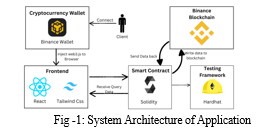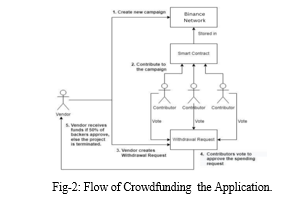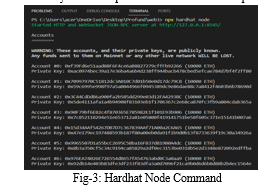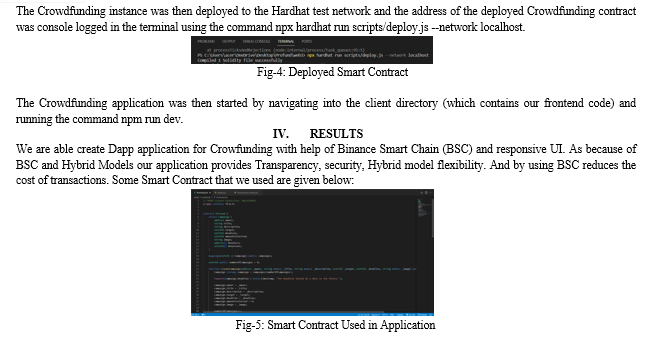Ijraset Journal For Research in Applied Science and Engineering Technology
- Home / Ijraset
- On This Page
- Abstract
- Introduction
- Conclusion
- References
- Copyright
Crowdfunding Application by Binance Blockchain and Hybrid Models
Authors: Viraj Shewale, Prasad Sutar, Vinit Kawachale
DOI Link: https://doi.org/10.22214/ijraset.2023.56267
Certificate: View Certificate
Abstract
As Web3 and blockchain develop faster in many areas such as healthcare, social services, electronic voting and more. Crowdfunding applications are leveraging BSC\'s efficiency and low transaction costs to bridge the gap between blockchain and traditional finance through a hybrid model. It combines the user-friendly React-based interface, secure Solidity smart contracts, and Hardhat\'s development and testing capabilities to create a versatile and secure platform. The goal of this project is to identify the value gap in the current crowdfunding market and provide them with smart contracts with smart tools for application businesses created by Ethereum. This crowdfunding app represents a significant step forward in fundraising, meeting many needs of customers and poised to shape the future of crowdfunding with its new and innovative approach.
Introduction
I. INTRODUCTION
Funding a project or some type of business by collecting money from many people, especially using the internet, is called crowdfunding. Crowdfunding has become a powerful tool to raise funds and support new projects, businesses and ventures. The integration of blockchain technology into public service applications has created a new era of transparency, security and efficiency. One of the main players in this space is the “Binance Blockchain Crowdfunding App”, a platform that uses the potential of Binance Smart Chain (BSC) to provide a unique and convenient crowdfunding experience.
Crowdfunding apps in general have limited security, so investors risk their money to support startups. Our effort to create this project is to create communication between investors and startups to prevent such frauds. Simply put, our goal is to create a secure platform where money can be raised without fear of fraud or corruption. This is where blockchain comes in handy. Blockchain is a distributed ledger used to record all transactions across multiple systems so that information cannot be changed later.
Hybrid models represent a revolution in the field of crowdsourcing as they connect traditional domains and blockchain domains. This model combines the transparency, security and other benefits of blockchain technology with the familiarity and accessibility of traditional payment methods.
Binance Smart Chain is a blockchain network created by Binance that has many advantages such as high scalability, low transaction fees and fast confirmation times. These features make it an attractive option for public service projects trying to overcome some of the challenges associated with traditional blockchain networks. Additionally, the large user base and strong infrastructure of the Binance ecosystem provide a good foundation for the crowdfunding scheme to be successful. Combining the benefits of blockchain technology with traditional financial systems, the platform solves many problems while providing many benefits to creators and supporters.
From start to finish, we'll cover the key features and benefits of the Binance Blockchain crowdfunding app, outline its commitment to compliance and investor protection, and examine how a hybrid model can bridge the gap between blockchain and traditional finance. Whether you are an investor looking to raise capital for a project or an investor looking for an exciting opportunity, reviewing the Binance Crowdfunding app will shed light on the platform that is changing against the crowd.
II. LITERATURE SURVEY
A. Crowdfunding in Blockchain
In this project, we are investigating the integration of blockchain into crowdfunding. Researchers have examined how blockchain can increase the transparency, security and efficiency of the fundraising process.
B. Binance Smart Chain(BSC)
It is important to understand the BSC process, such as its effectiveness and low costs. Research on BSC architecture, consensus mechanisms, and network dynamics provides insight.
C. Hybrid Models
We are exploring the concept of hybrid models and how they can combine blockchain with traditional finance to provide more payment options and increase accessibility.
D. Crowdfunding Smart Contract Security and Challenges
In this paper, we will talk about the differences in security and the difficulties you will encounter when using and after using a crowdfunding platform that uses blockchain. Smart contracts are becoming an important part of the parties involved in crowdfunding.
E. Blockchain is Revolution Crowdfunding
In this paper, we will explain the limitations of crowdfunding platforms and the benefits of blockchain technology and how it is the future of crowdfunding owing to the ease and transparency of this model.
F. Cross-Platform Compatibility
Explore cross-platform compatibility and the impact of expanding cross-platform collaboration across multiple blockchain networks.
G. Blockchain and its Needs
A Blockchain is immutable, decentralized and distributed database and ledger that is shared among the nodes of a computer network. Blockchain works as a database that stores information and tracks transactions electronically in a digital format. Blockchain maintains a secure and decentralized track record of transactions. The specialty of Blockchain is that it is secure and maintains fidelity throughout the record.
Data in the blockchain is stored in groups called "blocks". A block is a structure that stores a set of data. Blocks have a storage function that allows them to be linked to previous blocks, thus forming a blockchain, hence the name blockchain.
Blockchain technology provides a secure, transparent and decentralized way to record and verify transactions. Its appeal stems from its ability to build trust and eliminate the need for intermediaries across the business.
Blockchain protects against tampering, reduces fraud and ensures data integrity. Its decentralized structure reduces the risk of a single failure and increases efficiency. Additionally, blockchain-based smart contracts and digital currencies can simplify processes, reduce costs and increase efficiency.
Overall, blockchain solves trust, security, and efficiency issues, making it useful in finance, supply chain, healthcare, and many other industries looking to update and improve performance.
H. Hashing in Blockchain
Binance Blockchain and Hybrid Model Hashing of large amounts of money is a simple security measure. It involves converting sensitive data or transaction details into a long alphanumeric string called a hash.
Hashes serve several purposes: First, they protect user privacy and increase data security by hiding personal information. Second, they ensure the integrity of financial transactions and smart contracts by creating unique identifiers for each document. This will help prevent fraud and tampering. Finally, hashes facilitate the consensus in blockchain collaboration necessary to authenticate and verify transactions. In general, hash is an important factor in ensuring the stability and trust of crowd and hybrid models in the Binance blockchain ecosystem.
I. Smart Contracts
Smart contracts automate the execution of contracts between buyers and sellers by writing everything directly into the line of code. Therefore, it helps to display the results to all participants without the involvement of third parties.
Smart contracts work by using “if/when…then…” conditions that are written into code on a Blockchain. A network of computer systems carries out the actions when these predetermined conditions have been verified and met. These actions mostly include releasing funds to the appropriate parties, registering a vehicle, sending notifications, or issuing a ticket. The Blockchain is then updated when the transaction is completed. That means the transaction cannot be changed, and only parties who have been granted permission can see the results.
III. METHODOLOGY
A. Architecture
Fig. 1. represents the architecture of our Crowdfunding application. This shows how our web application with Solidity as our backend works. All the smart contracts that interact with the Ethereum blockchain are written in Solidity language . We have also used Hardhat , which is an Ethereum development environment, along with the Chai assertion library to perform various tests on our smart contracts. We use React.js as a frontend to serve JavaScript content to the browser. When a user performs an action, it does not reach the server. Instead, the Binance app runs in a web browser using web3 and communicates with the Binance Smart Chain (BSC). enter the key and send the transaction to the EVM network. These changes can be tracked in BSC to ensure transparency throughout the entire process. These public and private keys are never sent to the server because you cannot ask the user for their private number. So here the customer has more power and privacy.

B. Proposed System
Binance-based smart contract is an encrypted box that stores information, processes inputs, records outputs and can only be accessed from the outside if certain prerequisites are met, and contracts on Binance Smart Chain are created using a custom script. It is called "robustness". In fact, Binance can easily implement smart contracts, and BSC also provides developers with online scripts for reliable codes. The smart contract is written in such a way that all the money the provider receives is stored in the smart contract so that no one can change or steal it. This money is not given directly to the event creator, but resides in the smart contract itself.The following are the 6 modules that our application takes care of:
- Wallet Connect: Users must have a cryptocurrency wallet (such as Metamask) to interact with our application. Initially, when a user enters our decentralized crowdfunding app, the cryptocurrency wallet is connected and then the user can make various transactions.
- Campaign Creation: Users can create a campaign by providing relevant details such as campaign name, campaign description, donation amount, minimum donation amount, application deadline. A small gas fee is charged for each transaction. So for every transaction that needs to happen on the blockchain, we need to provide some amount of money for that transaction to be valid. When the transaction is completed after a few seconds, a new block containing the address of the contract will be added to the Ethereum blockchain. The Home Page then also displays this newly created campaign, with which the user as well as the contributor can interact.
- Contributions: Donors can search our app to look for events that might interest them. When donors find a campaign they like, they can support the campaign by donating Ether. After that, a Metamask pop-up will appear to confirm the change. The donor now becomes a supporter of the campaign and plays a role in deciding whether sellers will receive the revenue generated to date.
- Hybrid Payment Options: To bring crowdfunding to a wider audience, the system offers hybrid payment options. Supporters can choose to donate using cryptocurrencies (e.g. BNB, BTC, ETH) or traditional fiat money via credit/debit card or wire transfer. This change supports the participation of users with different levels of blockchain knowledge.
- Withdrawal Request: When a developer wants to withdraw some Ether from the funds he has earned so far for his campaign, he must first create a withdrawal request. The proposal must be approved by at least half of the campaign sponsors. If 50% is not voted, the seller will not be able to withdraw the money and will have to wait for people to vote again.
- Approval: When a seller wants to spend money, the cancellation request is notified to all sponsors. Therefore, the buyer must approve the request if he wishes. A participant can vote on a proposal for a sponsor, for example. Supporters can show their approval by clicking the "Vote" button next to the seller's removal request. This will then process transactions, pay a small fuel fee and add a block to the blockchain.
- Finalize Campaign: If the seller can achieve 50% support, it means that at least half of the people support the trust and support the campaign and are happy with the seller's request to spend money. Ether will be sent directly to the verification provider. If the budget target is not achieved, the project will be terminated. All transactions taking place will be stored on the blockchain to ensure transparency in the entire process.

.C. Technology Used
There are various technology and tools used while building Crowdfunding application in which some of them are :
- React and Tailwind CSS: React is used for building the user interface. It enables the creation of dynamic, responsive, and user-friendly web pages, making it an essential technology for user interactions. And for responsive and interactiveness is handle by Tailwind Css.
- Solidity: Solidity is a programming language specifically designed for creating smart contracts on blockchain networks. It is used to enforce the rules of the fund committee, including planning, financial management and payment rules.
- Hardhat: Hardhat work as a development environment for Ethereum compatible blockchains such as Binance Smart Chain. It allows developers to write and test smart contracts, run tests, and upload them to the blockchain.
- Binance Smart Chain: Based on blockchain technology, BSC provides an honest ledger for the handling of large amounts of money. It has a fast market and low cost, making it ideal for crowdfunding.
- Web3.js: Web3.js is used to interact with the BSC blockchain from the frontend. It enables communication with smart contracts, retrieval of blockchain data, and transaction handling.
- GitHub: GitHub or similar version control platforms are used to manage the source code, collaborate among development teams, and track changes.
D. Deployment
First, we need to install hardhat and we load the local blockchain created by Hardhat to test and deploy our smart contract written in solidity. You can enter npx hardhat node to know addresses of various users. As BSC is EVM-compatible, which means you can use the same Solidity language and many of the Ethereum development tools. However, you need to connect your development environment to the BSC network. Ensure that your development environment is set up to target BSC's RPC endpoints


Conclusion
In conclusion, the Binance Blockchain and hybrid model crowdfunding application built using React, Solidity, Harhat and Binance Smart Chain (BSC) represents a significant step into the world of crowdfunding. It successfully combines the functionality of blockchain technology with the development of hybrid models to provide an accessible, secure and transparent crowdfunding platform. The app\'s low cost, security features, user training and compliance management increase its reliability and attract different users. In this paper, we have realized that integrating blockchain technology with the traditional crowdfunding platform has helped eradicate the many weaknesses present in normal crowdfunding processes by creating a decentralized platform to remove the concept of central authority thereby eliminating the need for intermediaries, providing transparency of transactions. More efforts are needed to ensure collaboration with various blockchain networks, scaling globally to meet different regulatory requirements, and ongoing research to comply with new standards. Community engagement is key to collecting user feedback and encouraging continuous innovation, making the platform competitive and relevant in a changing crowd.
References
[1] Lee, Jei Young. “A decentralized token economy: How blockchain and cryptocurrency can revolutionize business.” Business Horizons 62.6 (2019): 773-784. [2] Geetika Jhanji, Vidushi Tyagi, Aditya Gaur, Yogesh Sharma. “Development of a Crowdfunding application Powered by Ethereum Blockchain.” 2023. 1-7. [3] Alkhana Abuhashim, Chiu C. Tan. “Smart Contract Design on Blockchain Applications.” 2020. [4] Faten Adel Alabdulwahhab. “Web3.0 : The Decentralized Web.” 2018. [5] D Sathya, S Nithyaroopa, D Jagadeesan, I Jeena Jacob. “Blockchain Technology for Food Supply Chains.” 2021. [6] Shivendra, Dr.Kasa Chiranjeevi, Mukesh Kumar Tripathi, Dr. Dhananjay D. Maktedar. “Block chain Technology in Agriculture Product Supply Chain.” 2021. [7] Mrs.M.C.Jayaprasanna, Ms.V.A.Soundharya, Ms.M.Suhana, Dr.S.Sujatha. “ A Blockchain based Management System for Detecting Counterfit Product in Supply Chain.” 2021. [8] Lee, Wei-Meng. “Using the Metamask chrome extension.” Beginning Ethereum Smart Contract Programming. Apress, Berkeley, CA, 2019. [9] Faheem Ahmad Reegu, Salwani Mohd Daud, Shadab Alam, Mohammedd Shuaib. “Blockchain-based Electronic Health Record System for efficient Covid-19 Pandemic Management.” 2020. [10] Wathan, A. “Tailwind CSS: A utility-first CSS framework for rapid UI development.” 2021. [11] Banks, Alex, and Eve Porcello. “Learing React: functional web development with React and Redux.” 2017. [12] Palechor, Luisa, and Cor-Paul Benzemer. “How are Solidity Smart contracts tested in open source projects? An exploratory study.” 2022. [13] Olivier, Starkenmann, Karl Schmedders, and José Parra Moyano. \"Implementation of a Crowdfunding Decentralized Application on Ethereum Master Thesis.\" [14] Sarmah, Simanta Shekhar. \"Understanding blockchain technology.\" Computer Science and Engineering 8.2 (2018). [15] F.Casino, T.K. Dasaklis and C. Patsaki. “A systematic litreture review of blockchain based applications: Current status Classification and open issues.” 2019.
Copyright
Copyright © 2023 Viraj Shewale, Prasad Sutar, Vinit Kawachale. This is an open access article distributed under the Creative Commons Attribution License, which permits unrestricted use, distribution, and reproduction in any medium, provided the original work is properly cited.

Download Paper
Paper Id : IJRASET56267
Publish Date : 2023-10-23
ISSN : 2321-9653
Publisher Name : IJRASET
DOI Link : Click Here
 Submit Paper Online
Submit Paper Online

